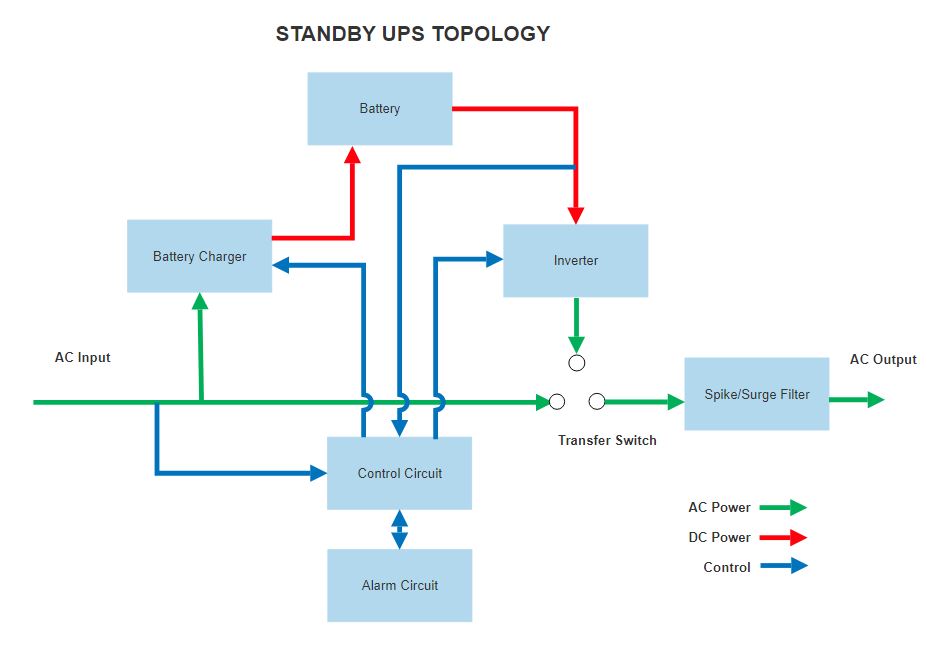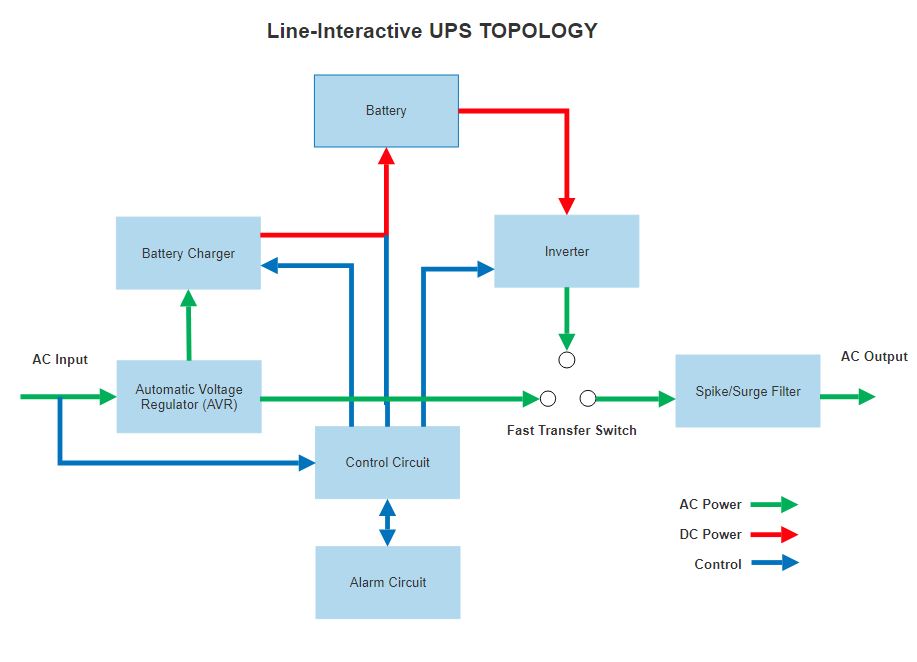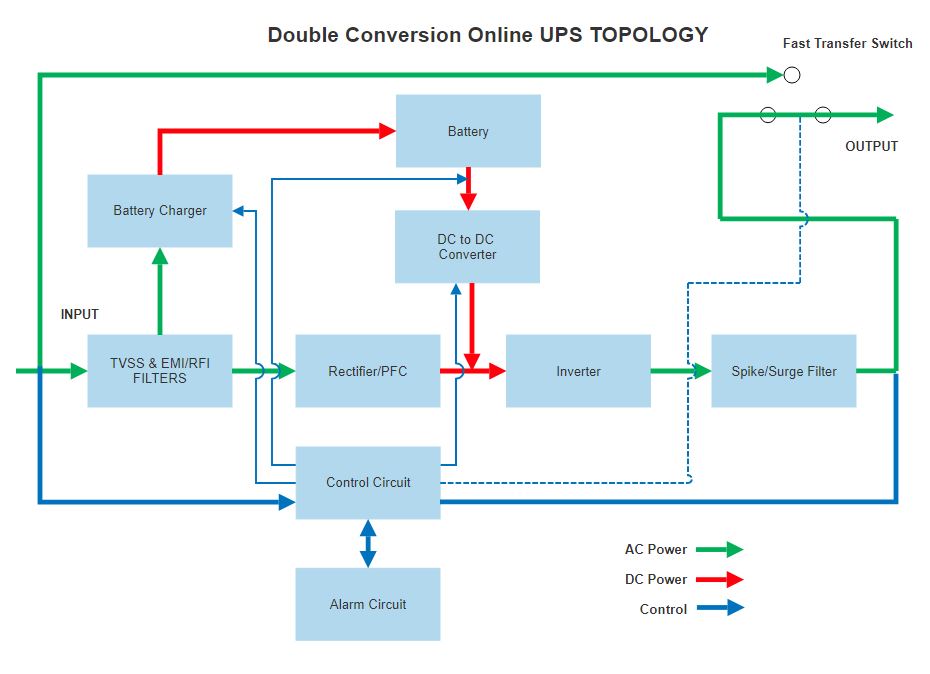Standby UPS
The standby UPS (Uninterruptible Power Supply) topology is a simple and cost-effective design configuration used to provide basic power protection for electronic equipment. In this topology:
- Input Stage: The incoming AC power from the mains supply is directly passed through to the connected load without any alteration.
- Battery Backup: The UPS continuously charges its internal battery while mains power is available. The battery serves as a backup power source in the event of a power outage or significant voltage fluctuation.
- Transfer Switch: When the UPS detects a loss of mains power or an abnormal voltage level (e.g., voltage drop or surge), a transfer switch is activated to disconnect the load from the mains supply and connect it to the battery power source.
- Inverter Stage: Once the load is connected to the battery, an inverter is activated to convert the DC power stored in the battery into AC power suitable for powering the connected load.
Key features and characteristics of the standby UPS topology include:
- Basic Power Protection: Provides basic protection against power outages and voltage fluctuations by seamlessly switching to battery power when necessary.
- Simple Design: The standby UPS topology is relatively straightforward in design, making it cost-effective and easy to implement.
- Fast Switchover Time: Typically has a fast switchover time, ensuring minimal disruption to the connected load during power transitions.
- Limited Voltage Regulation: While standby UPS systems may provide some level of voltage regulation, it is often minimal compared to other UPS topologies like line-interactive or double conversion online UPS.
- Suitable for Non-Critical Applications: Due to its simplicity and lower cost, standby UPS systems are commonly used to protect non-critical equipment, such as desktop computers, networking devices, and home entertainment systems.
Overall, the standby UPS topology offers a basic level of power protection suitable for applications where occasional power outages or voltage fluctuations occur, and where more advanced features and higher levels of protection are not required.
Line Interactive UPS
The line-interactive UPS topology is a common design configuration used in uninterruptible power supply systems. In this topology:
- Input Stage: The incoming AC power from the mains supply is fed directly to the connected load. Simultaneously, a small portion of the power is diverted to the UPS system for monitoring and conditioning purposes.
- Automatic Voltage Regulation (AVR): The UPS includes an AVR mechanism that regulates the voltage level of the incoming power within a certain range. If the input voltage deviates from the acceptable range (either too high or too low), the AVR adjusts the voltage to ensure that the output remains within the specified limits. This helps to protect connected equipment from voltage fluctuations without relying solely on the battery backup.
- Battery Backup: In the event of a power outage or significant voltage fluctuation beyond the AVR’s capacity to correct, the UPS switches to battery power to continue supplying electricity to the connected load. This switchover typically occurs within milliseconds to ensure uninterrupted power supply.
- Inverter Stage: The UPS includes an inverter that converts the DC power from the battery into AC power, which is then supplied to the connected load. During normal operation, when mains power is available and within acceptable voltage limits, the inverter remains inactive.
Key features and advantages of the line-interactive UPS topology include:
- Voltage Regulation: Protects connected equipment from voltage fluctuations by automatically adjusting the voltage within a predefined range.
- Battery Backup: Provides backup power during outages or significant voltage fluctuations to ensure continuous operation of critical equipment.
- Fast Switchover Time: Switches to battery power quickly (typically within milliseconds) to prevent any interruption in power supply to the load.
- Efficiency: Generally more efficient than double conversion online UPS systems since the inverter remains inactive during normal operation, thus reducing energy consumption.
- Cost-Effectiveness: Offers a balance between protection and cost, making it suitable for applications where moderate protection against power disturbances is required without the high cost of a double conversion UPS.
Overall, the line-interactive UPS topology is well-suited for protecting sensitive electronic equipment, such as computers, networking devices, and home or small office setups, against common power issues like voltage sags, surges, and brief outages.
Double Conversion Online UPS
Isolated Online UPS
Galvanic isolated UPS topology refers to a design configuration in which there is complete electrical isolation between the input and output sides of the UPS system. This isolation is achieved through the use of a transformer or similar isolation device.
In a typical galvanic isolated UPS system:
- Input Stage: The input stage of the UPS rectifies the incoming AC power from the mains supply and converts it to DC power. This DC power is then used to charge the battery bank and power the inverter stage.
- Isolation Transformer: The key component that provides galvanic isolation is the isolation transformer. It is placed between the input and output sides of the UPS. The transformer electrically separates the input and output circuits while allowing power transfer through electromagnetic induction.
- Inverter Stage: The inverter stage converts the DC power from the battery or rectified mains supply back into AC power. This AC power is then used to supply the connected equipment on the output side of the UPS.
- Output Stage: The output stage of the UPS provides power to the connected load. It may also include additional filtering or conditioning components to ensure a clean and stable power supply to sensitive equipment.
Key characteristics and advantages of galvanic isolated UPS topology include:
- Electrical Isolation: Complete separation between input and output circuits, which enhances safety and protects connected equipment from electrical hazards.
- Noise Reduction: Helps in minimizing electrical noise or interference, which is crucial for sensitive laboratory equipment.
- Grounding Flexibility: Allows for different grounding configurations without creating ground loops or potential differences between equipment.
- Equipment Protection: Protects against power surges, voltage spikes, and other disturbances, thus extending the lifespan of connected devices.
- Compliance: Meets regulatory standards and safety requirements for critical applications, such as laboratory environments where precision and reliability are paramount.
Overall, galvanic isolated UPS topology ensures reliable and safe operation of laboratory equipment by providing a clean, stable, and isolated power supply.
Isolated Online UPS Products Include: TX91




